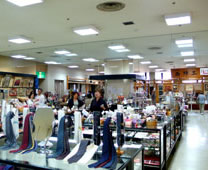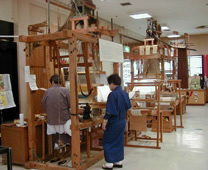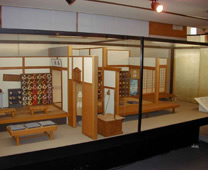
Travel Guide
Introduction
The Nishijin Textile Center is a perfect place to come both for those interested in textiles and willing to know more about this old tradition as well as for those who would like to shop for traditional Japanese souvenirs.
You can see weaving demonstrations by master craftspeople working by hand and by loom. Japanese and Western items, such as kimono sashes and neckties made of Nishijin material can be purchased at the center, and kimono fashion shows are held free of charge multiple times a day. You can also get dressed up as an apprentice geisha in a traditional, twelve-layered ceremonial kimono, once worn by court ladies, and have your picture taken.
There is a gallery on the 3rd floor, which displays the most valuable and outstanding textiles in the history of Nishijin tradition. The gallery exhibition changes several times a year.
Histrory
The history of Nishijin is the history of Kyoto textiles itself. The word Nishijin comes from the two Japanese words, Nishi, being “West” and Jin being “camp”. Although nowadays most Japanese associate the name "Nishijin" with textile production, the origin of the name "Nishijin" dates back to the 15th century, when the Onin War was being waged in Kyoto. Nishijin was the area of Kyoto where the western rebel army was located. When the war ended, the weavers who had fled from Kyoto during the period of the war came back to the city and settled down in Nishijin area. Eventually, this center of textile production came to be called "Nishijin".
Even though the name "Nishijin" only originated about 500 years ago, the tradition of textile weaving that continues to this day, goes back to the Heian period (from 794 AD), being one of the most important crafts in Japan for more than 1200 years, by using many different types of colored yarns and weaving them together into decorative designs. These specialized procedures are tedious, but necessary to obtain the spectacular design needed to ensure the quality of Nishijin.
By the Edo Period (1603–1867), there were an estimated 7,000 looms crammed into 160 city blocks comprising the Nishijin District. Unsurprisingly, the district suffered a terrible blow when the capital was moved to Tokyo and when Western clothes were introduced to Japan during the Meiji era (1868-1912), but the industry bounced back by adopting Western weaving technology and equipment, which allowed them to produce machine-woven inexpensive clothing alongside luxurious hand-woven fabrics.
Today, Nishijin is one of the country's largest districts for hand weaving, with this commemorative museum located on the very spot where merchants once gathered to bid for elegant textiles sold at auction.
 |
 |
 |
| Souvenir shop | Headweaving demonstrations | Exhibition room |
Travel Advice
Multi-language brochuresFor the tourists from worldwide, Nishijin Textile Center provides the brochures in English, Chinese, Korea and Japanese. ExperienceThe center provides kimono waring experience such as Komon, Yukata, 12-layered kimono and Sokurai, Maiko and Geisha. Hands-on weaving experience allows you to try your hand at weaving a piece of fabric on mini-looms using traditional methods. Please make reservation in advance for each course. Please visit the official site for detail and reservation. Kimono ShowTime: 10:30 / 11:30 / 13:00 / 14:00 / 15:00 / 16:00 Admission: Free Duration: 10 minutes Handweaving DemonstrationVisitors can see a demonstration of hand weaving by skilled craftsmen. |
Visit
| Address | Horikawa-dori Imadegawa Minami-iru, Kamigyo-ku, Kyoto-shi, Kyoto | |
| Phone | 075-451-9231 | |
| Admission | Free | |
| Hours | 09:00 to 17:00 Nov 1 to the last date of Fed 09:00 to 17:00 Mar 1 to Oct 31 |
|
| Closed | December 29 to January 3 | |
| Duration | 45 minutes | |
| Getting There | By Train 25 minutes ride by City Bus No.9 from JR Kyoto Station to the Horikawa Imadegawa bus stop, then walk approximately 1 minute. 20 minutes ride by City Bus No.12, 51 or 59 from Sanjo Keihan Station on subway Tozai Line to the Horikawa Imadegawa bus stop, then walk approximately 1 minute. 20 minutes ride by City Bus No.12 from Kawaramachi Station on Hankyu Railway Kyoto Honsen to the Imadegawa bus stop, then walk approximately 1 minute. 15 minutes ride by City Bus No.12 from Karasuma Station on Hankyu Railway Kyoto Honsen to the Imadegawa bus stop, then walk approximately 1 minute. 20 minutes ride by City Bus No.201 from Omiya Station on Hankyu Railway Kyoto Honsen to the Imadegawa bus stop, then walk approximately 1 minute. 7 minute walk from Imadegawa Station on subway Karasuma Line. By Car Take Meishin Expressway to the Kyoto-higashi exit. It is approximately 8 kilometers 30 minutes from exit. |
|
| Parking | Paid parking available | |

